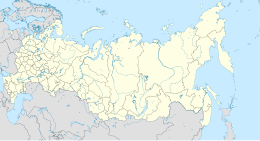Salm Island

Location of Salm Island and its neighboring islands in the Franz Josef Archipelago
|
|
| Geography | |
|---|---|
| Location | Arctic Ocean |
| Coordinates | 80°04′N 59°16′E / 80.067°N 59.267°E |
| Archipelago | Franz Josef Land |
| Length | 20 km (12 mi) |
| Highest elevation | 343 m (1,125 ft) |
| Highest point | Chernyshev Ice Cap |
| Administration | |
|
Russia
|
|
Salm Island (Russian: oстров Сальм; Ostrov Sal'm) is a roughly round-shaped island in Franz Josef Land, Arkhangelsk Oblast, Russia.
Salm Island was named by the Austro-Hungarian North Pole Expedition after the Salm-Hoogstraten aristocratic dynasty to which Count Karl Alexander, one of the expedition's main sponsors, belonged.
Salm Island is almost completely glacierized except for two headlands in its western and its southern shore. The Chernyshev Ice Cap (Lednik Chernysheva) covers most of the island. Salm Island's maximum length is 17 km (11 mi) and its area is 344 km2 (133 sq mi). The highest point of the island is 343 m high summit of the Chernyshev Ice Cap.
Salm Island is surrounded by smaller islands. Ostrova Bisernyye are two small islets located right off Salm Island's southern shore.
Southwest of Salm Island lies 10 km (6 mi) long Wilczek Island (oстров Вильчека) —which should not be confused with Wilczek Land in the same archipelago. It is separated from Salm Island by a 3 km (2 mi) wide sound. This island is named after Austro-Hungarian nobleman Johann Nepomuk Graf Wilczek.
4 km (2 mi) southeast of Salm Island lies small and round Litke Island (oстров Литке). Its area is 14 km2 (5 sq mi) and it was named after Russian Count Fyodor Petrovich Litke.
A few miles to the northeast lie the Hochstetter Islands (oстрова Гохштеттера or oстрова Хохштеттера), made up of a 6.5 km (4 mi) long by 4 km (2 mi) wide island, Hochstetter Island (also known as Gogstettera Yuzhnyy), and two smaller islets Gogstettera Sredniy and ostrov Al'batros. The Hochstetter Islands are named after the German Hochstetter princely dynasty of the Austro Hungarian Empire.
...
Wikipedia

